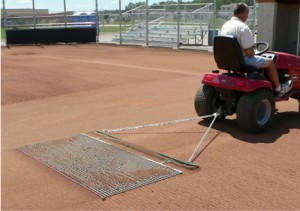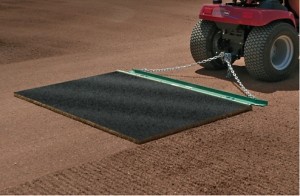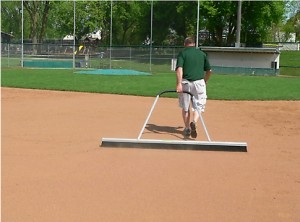Float Dragging Protocol !
Float dragging is the finishing portion of maintaining the infield skin surface. There are several different tools to use to give you a finished feel and look to the skin area. The common ones include the ever-popular steel mat drag, the cocoa mat drag, and the broom drag.

-
- STEEL MAT DRAG: Can be used in any type of soil. It is the only finish drag that will break up small soil clumps. Because of the way this drag is constructed, it transports infield material around because the steel mat drag must load up before it will drop off material. This can be used to a groundskeepers advantage to help cut down high spots and fill low spots.
-
- COCOA MAT DRAG:Should be used only on topdressed or very sandy infields. These drags are made using a dense stand of cocoa fibers embedded in a vinyl backing. Because these fibers are so dense, there is little if any transporting of infield materials. If you are towing one of these behind a vehicle, I highly recommend a leveling bar being attached in front of the cocoa drag to disperse any large piles of loose infield material or topdressing since the cocoa drag can’t grab it.
- DRAG BROOM: Just like the cocoa mat drag, the drag broom works best on topdressed infields and very sandy infield soils. They will not break up the soil chunks seen on heavier soil infields. Drag brooms hover over the surface, smoothing them out without transporting excess material.
I’m often asked, “Which drag should I get?” The answer is somewhat complicated. The steel mat drag works on any type of infield skin. The cocoa mat drags and the drag brooms work best on topdressed or very sandy infields. But ultimately, I like to have both a steel mat and a cocoa mat or drag broom in my shed. Why? Because the steel mat drag I will use whenever I need to manipulate my infield material by moving soil from high spots to low spots. Then, on a topdressed field, I would also have the cocoa mat or drag broom in my shed for when I just want to hover over the infield skin to just smooth everything out without transporting any material around. It’s a small price to pay to have all your options available for maintaining your infield skin.
When actually float dragging the infield skin, keep these tips in mind:
- If pulling your drag with a vehicle proceed slowly, especially when cornering, to avoid “bowling out” the skin area.
- Keep the vehicle towed drag at least 6 inches away from the infield skin edges. Use a hand drag to go along the edges. You will have more accurate control of the hand drag.
- Just like when nail dragging, float drag your skinned areas in patterns perpendicular to each other to insure a smooth playing surface.
- Start your float dragging in high areas (along the back arc edge of the infield or the 1st & 3rd base corners of a baseball infield) and finish in low spots (around bases and players positions) to help reduce low spots which lead to water ponding in rain situations.
- Use a leveling bar in front of a towed drag mat to grab piles of loose material and spread them out ahead of the drag mat.
- If hand dragging, walk a steady pace and don’t bounce your arm that you are pulling the drag with in order to avoid the drag bouncing and leaving ripples on the skin surface.
- When finished, use a sifting shovel to screen any contaminants (rocks, pebbles, sticks, grass clippings, etc.) from the spoils left at the end of the drag and follow up using a level board to evenly distribute the remaining spoils around the area.
By properly maintaining the surface grade of your infield you will reduce, if not eliminate, any problems you will face during rainy weather. Additionally, the infield skin will play more true for the players who scamper around your infield.





0 Comments